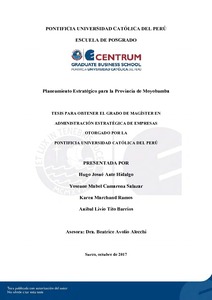| dc.contributor.advisor | Avolio Alecchi, Beatrice Elcira | |
| dc.contributor.author | Ante Hidalgo, Hugo Josué | es_ES |
| dc.contributor.author | Camarena Salazar, Yoseane Mabel | es_ES |
| dc.contributor.author | Marchand Ramos, Karen | es_ES |
| dc.contributor.author | Tito Barrios, Aníbal Livio | es_ES |
| dc.date.accessioned | 2017-10-30T22:17:17Z | |
| dc.date.available | 2017-10-30T22:17:17Z | |
| dc.date.created | 2017 | |
| dc.date.issued | 2017-10-30 | |
| dc.identifier.uri | http://hdl.handle.net/20.500.12404/9602 | |
| dc.description.abstract | Este planeamiento estratégico para la provincia de Moyobamba al 2035 se elaboró
siguiendo la metodología del Modelo Secuencial del Proceso Estratégico de D´Alessio
(2015). La provincia de Moyobamba es una de las 10 que conforman la región de San Martín.
Su población se dedica principalmente a la agricultura, y su producto más cultivado es el
café. Sus altos niveles de pobreza y bajo nivel de educación, acompañados de la presencia
generalizada de corrupción, no han permitido que la provincia se desarrolle adecuadamente.
Para generar desarrollo económico sostenido con igualdad y acceso a servicios de calidad, el
presente plan estratégico plantea los siguientes objetivos al 2035: (a) incrementar la cantidad
de personas trabajando en actividades industriales, (b) incrementar los turistas nacionales y
extranjeros, (c) incrementar el acceso a servicios básicos, (d) incrementar el índice de
desarrollo humano y (e) mejorar la infraestructura vial. Si se cumplen estos objetivos se
logrará la visión de ser un referente en turismo en el Alto Mayo, en producción agroindustrial
y calidad de vida.
Para alcanzar los objetivos propuestos, se plantea el desarrollo del potencial turístico
de la provincia, ya que al poseer atractivos naturales en la ruta Tarapoto - Kuélap, puede
integrar un eje turístico importante para la selva norte. Por otro lado, se tiene el potencial del
café; y el sacha inchi que, a pesar de no contar con fuerte presencia en la provincia,
representa una gran oportunidad de desarrollo agroindustrial. Para estos dos productos, se
busca construir una industria productiva de valor agregado que permita atender el mercado
local e internacional. Las estrategias antes mencionadas permitirán que el PBI de la provincia
casi se cuadruplique hacia el 2035 y, por ende, genere mayor bienestar para sus pobladores | es_ES |
| dc.description.abstract | This paper presents the strategic planning for the province of Moyobamba, developed
for the period up to 2035, based on the Sequential Model of Strategic Process (D'Alessio,
2015). The province of Moyobamba is one of ten provinces that constitute the region of San
Martin. Its population is mainly devoted to agricultural activities, with coffee being the most
cultivated product. Moyobamba’s high poverty rates and low education levels, in addition to
the presence of widespread corruption, have prevented this province from developing
properly. In order to generate sustainable economic development, along with equality and
access to quality services, this strategic planning sets out the following goals towards 2035:
(a) Increase the number of people who will be engaged in industrial activities; (b) increase
the domestic and international number of tourists; (c) increase access to basic services; (d)
increase the Human Development Index; and (e) improve road infrastructure. The
achievement of these goals will allow attaining the vision of becoming a benchmark in
tourism, in agro-industrial production and quality of life in the Alto Mayo area.
In order to reach the suggested goals, the proposal is to foster the development of the
province’s tourism potential, given that its natural attractions in the Tarapoto – Kuelap route,
makes it an excellent candidate to integrate an important tourism hub in Peru’s northern
jungle region. Moreover, there exists a great potential from coffee, and from sacha inchi,
despite the latter not having a strong presence in the province, it represents a great
opportunity for agro-industrial development. Based on these two products, the aim is to build
an added-value production industry that will allow supplying both the domestic and
international markets. The above-mentioned strategies should allow a fourfold growth in the
province’s GDP by 2035; and therefore, generating greater well-being for its inhabitants | es_ES |
| dc.language.iso | spa | es_ES |
| dc.publisher | Pontificia Universidad Católica del Perú | es_ES |
| dc.rights | info:eu-repo/semantics/openAccess | es_ES |
| dc.rights.uri | http://creativecommons.org/licenses/by-nc-nd/2.5/pe/ | * |
| dc.subject | Planificación regional -- Perú -- San Martín | es_ES |
| dc.subject | Desarrollo regional -- Perú -- San Martín | es_ES |
| dc.subject | Planificación estratégica | es_ES |
| dc.title | Planeamiento estratégico para la Provincia de Moyobamba | es_ES |
| dc.type | info:eu-repo/semantics/masterThesis | es_ES |
| thesis.degree.name | Maestro en Administración Estratégica de Empresas | es_ES |
| thesis.degree.level | Maestría | es_ES |
| thesis.degree.grantor | Pontificia Universidad Católica del Perú. CENTRUM | es_ES |
| thesis.degree.discipline | Administración Estratégica de Empresas | es_ES |
| renati.discipline | 413307 | es_ES |
| renati.level | https://purl.org/pe-repo/renati/level#maestro | es_ES |
| renati.type | https://purl.org/pe-repo/renati/type#tesis | es_ES |
| dc.publisher.country | PE | es_ES |
| dc.subject.ocde | https://purl.org/pe-repo/ocde/ford#5.02.04 | es_ES |






